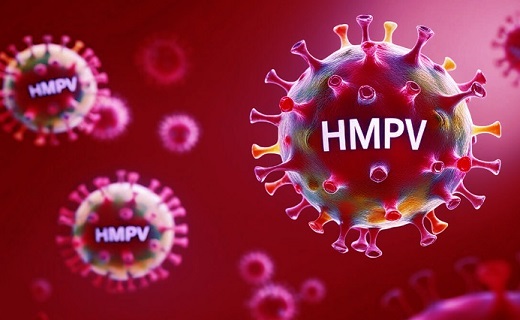Human Metapneumovirus (HMPV) Triggers Mucin 19 Expression Which Drives Viral Pathogenesis
Nikhil Prasad Fact checked by:Thailand Medical News Team Jan 08, 2025 11 months, 1 week, 5 days, 36 minutes ago
Medical News: Researchers from Louisiana State University-USA have uncovered critical insights into how Human Metapneumovirus (HMPV) interacts with the respiratory system. HMPV, a common culprit behind acute respiratory infections, predominantly impacts children, the elderly, and those with compromised immune systems. The infection’s symptoms range from mild respiratory discomfort to severe pneumonia, often necessitating hospitalization.
 Human Metapneumovirus (HMPV) Triggers Mucin 19 Expression Which Drives Viral Pathogenesis
Human Metapneumovirus (HMPV) Triggers Mucin 19 Expression Which Drives Viral Pathogenesis
This
Medical News report highlights a groundbreaking study revealing the pivotal role of a mucus component - Mucin 19 - in the immune response and disease progression associated with HMPV. These findings promise to reshape our understanding of respiratory health and viral pathogenesis.
The Protective Role of Mucus
Mucus, often regarded as the body’s frontline defense in the respiratory tract, is a gelatinous substance produced to trap pathogens, facilitating their removal. A crucial component of mucus is mucins, large glycoproteins that impart its unique viscoelastic properties. Among the mucins, Mucin 19 (MUC19) has recently drawn attention for its pronounced expression during respiratory infections.
Using both human cell cultures and mouse models, the researchers demonstrated that MUC19 is uniquely upregulated in response to HMPV infection. Compared to other mucins, its levels were found to increase up to 77-fold in human bronchial epithelial cells within 24 hours of a HMPV infection.
In mice, the expression of Mucin 19 in the lungs was markedly elevated within hours of HMPV exposure. This finding aligns with earlier studies showing mucus’s protective role in respiratory infections. However, the team’s focus on Mucin 19 revealed an unexpected dual role in both immune defense and disease exacerbation.
Key Findings on Mucin 19 and Viral Pathogenesis
The researchers conducted experiments using genetically modified mice lacking the gene for Mucin 19 (Muc19 KO mice) and compared their responses to HMPV infection with normal mice. The results were striking:
-Reduced Disease Severity: Mice without Mucin 19 showed less severe symptoms, including diminished weight loss and faster recovery of normal body weight after infection.
-Lower Viral Load: These mice exhibited significantly lower levels of viral particles in their lungs three days post-infection, suggesting that Mucin 19 might inadvertently enhance viral replication.
-Decreased Inflammation: Inflammatory responses, marked by reduced recruitment of CD4+ T cells to the lungs and decreased levels of pro-inflammatory cytokines (e.g., IL-6, IL-1β, and TNF-α), were observed in Muc19-deficient mice.
This points to Mucin 19’s role in amplifying immune responses that can worse
n disease.
While mucus traditionally acts as a protective barrier, the study reveals that Mucin 19 also has a complex relationship with the immune system. By promoting CD4+ T cell recruitment, it potentially intensifies inflammation, which might worsen respiratory damage.
Implications for Future Research
This discovery underscores the need for a deeper understanding of mucins in respiratory health. The study’s authors highlight that Mucin 19 could serve as a double-edged sword - facilitating pathogen clearance but also promoting excessive immune responses.
Previous studies have documented similar roles for mucins in other viral infections. For instance, MUC1 in human breast milk and saliva has shown antiviral properties against HIV and rotavirus. Conversely, mucins like MUC2 have been implicated in increased inflammation in gut infections. Understanding these mechanisms could pave the way for targeted therapies to modulate mucus production during infections.
A New Path in Treating Respiratory Infections
Given the role of Mucin 19 in both viral replication and immune response, therapeutic strategies could be developed to balance its effects. For instance, reducing Mucin 19 production during severe infections might alleviate symptoms while preserving the mucus’s protective functions. Additionally, the findings could influence vaccine development by identifying molecular targets associated with mucin expression.
Conclusion
This study not only broadens our knowledge of the immune mechanisms at play during HMPV infections but also highlights the critical balance between defense and disease. By focusing on Mucin 19, researchers have uncovered a complex interplay between mucus production, immune response, and viral replication.
The implications extend far beyond HMPV, offering insights into how mucins might contribute to other respiratory infections. Future research could unravel new strategies to harness mucus’s protective capabilities while mitigating its potential to exacerbate disease.
The study findings were published in the peer-reviewed journal: Pathogens.
https://www.mdpi.com/2076-0817/9/9/726
For the latest HMPV News, keep on logging to Thailand
Medical News.
Read Also:
https://www.thailandmedical.news/news/chlorpromazine-found-to-inhibit-human-metapneumovirus-hmpv-by-blocking-virus-internalization
https://www.thailandmedical.news/news/doctors-in-brazil-warns-that-hmpv-can-cause-severe-pneumonia-even-in-healthy-adults
https://www.thailandmedical.news/news/in-2021-new-hmpv-variants-emerged-in-spain-drove-disease-severity-yet-no-genomic-surveillance-of-what-is-happening-today
https://www.thailandmedical.news/articles/hmpv-human-metapneumovirus
